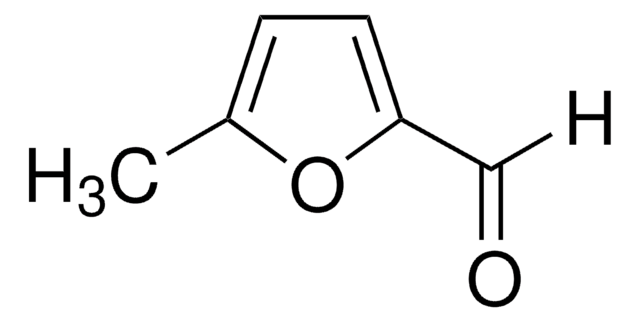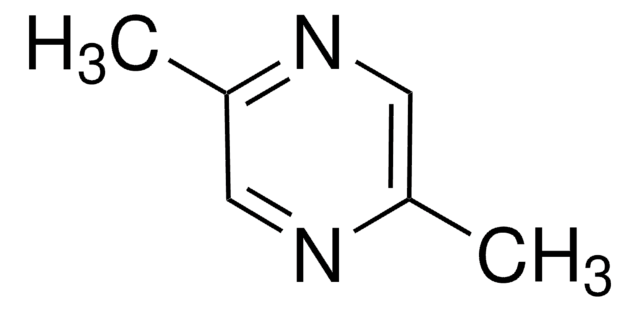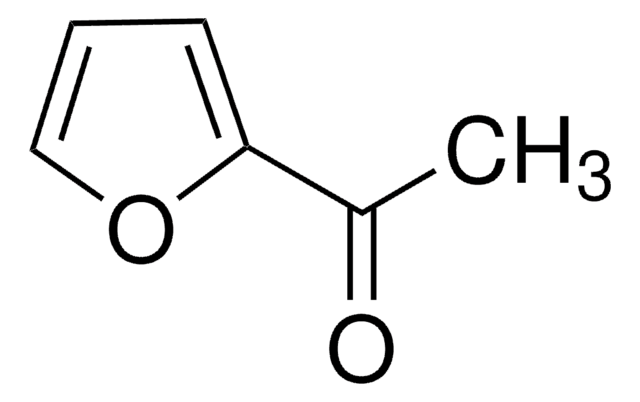W248908
Furfural
≥98%, FCC, FG
Synonym(s):
2-Furaldehyde, Furan-2-carboxaldehyde
About This Item
Fragrance grade
Halal
Kosher
Recommended Products
biological source
synthetic
Quality Level
grade
FG
Fragrance grade
Halal
Kosher
Agency
follows IFRA guidelines
meets purity specifications of JECFA
reg. compliance
EU Regulation 1223/2009
EU Regulation 1334/2008 & 178/2002
FCC
FDA 21 CFR 117
FDA 21 CFR 175.105
vapor density
3.31 (vs air)
vapor pressure
13.5 mmHg ( 55 °C)
Assay
≥98%
form
liquid
autoignition temp.
599 °F
expl. lim.
19.3 %
refractive index
n20/D 1.525 (lit.)
bp
162 °C (lit.)
mp
−36 °C (lit.)
density
1.16 g/mL at 25 °C (lit.)
application(s)
flavors and fragrances
Documentation
see Safety & Documentation for available documents
food allergen
no known allergens
fragrance allergen
no known allergens
Organoleptic
almond; baked; bread; woody; sweet
SMILES string
[H]C(=O)c1ccco1
InChI
1S/C5H4O2/c6-4-5-2-1-3-7-5/h1-4H
InChI key
HYBBIBNJHNGZAN-UHFFFAOYSA-N
Looking for similar products? Visit Product Comparison Guide
Application
- Intermolecular Diels-Alder Cycloadditions of Furfural-Based Chemicals from Renewable Resources.: Focuses on the regio- and diastereoselectivity of furfural in reactions with alkenes, highlighting its potential in developing bio-based polymers (Galkin and Ananikov, 2021).
Signal Word
Danger
Hazard Statements
Precautionary Statements
Hazard Classifications
Acute Tox. 2 Inhalation - Acute Tox. 3 Oral - Acute Tox. 4 Dermal - Aquatic Chronic 3 - Carc. 2 - Eye Irrit. 2 - Flam. Liq. 3 - Skin Irrit. 2 - STOT SE 3
Target Organs
Respiratory system
Storage Class Code
3 - Flammable liquids
WGK
WGK 2
Flash Point(F)
136.4 °F - closed cup
Flash Point(C)
58 °C - closed cup
Personal Protective Equipment
Choose from one of the most recent versions:
Already Own This Product?
Find documentation for the products that you have recently purchased in the Document Library.
Customers Also Viewed
Protocols
HPLC Analysis of Furans on Ascentis® Express C18
Separation of 5-Hydroxymethyl-2-furaldehyde; Furfuryl alcohol; Furfural; 2-Furyl methyl ketone; 5-Methyl-2-furaldehyde
Separation of Acetone; Acetic acid; Propionic acid; Ethyl butyrate; Ethanol; Isoamyl acetate; Isobutyric acid; 3-Methyl-2-butanol; Methyl acetate; 1-Propanol; Acetal, ≥98%, FG; 2-Methyl-1-pentanol; Butyl acetate; Ethyl propionate; 3-Pentanol; 2-Pentanol, 98%; Ethyl isobutyrate; Isobutyl acetate; Acetaldehyde; Furfural; Butyric acid; Methanol; Ethyl acetate
-Cymene; 2,5-Dimethylpyrrole; Acetoin, ≥96%, FCC, FG; 2,5-Dimethylpyrazine; 2,6-Dimethylpyrazine; 2-Ethylpyrazine, ≥98%, FG; 2,3-Dimethylpyrazine; 4-Heptanone; 3-Ethylpyridine; 2,3,5-Trimethylpyrazine; Furfural; Pyrrole; Furfuryl acetate; Linalool; Linalyl acetate; 5-Methylfurfural; γ-Butyrolactone; 2-Acetyl-1-methylpyrrole; Furfuryl alcohol; 2-Acetylpyrrole; Pyrrole-2-carboxaldehyde
Our team of scientists has experience in all areas of research including Life Science, Material Science, Chemical Synthesis, Chromatography, Analytical and many others.
Contact Technical Service











